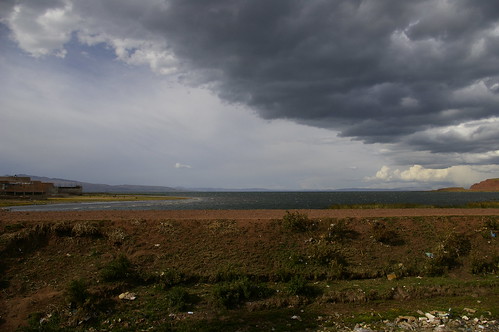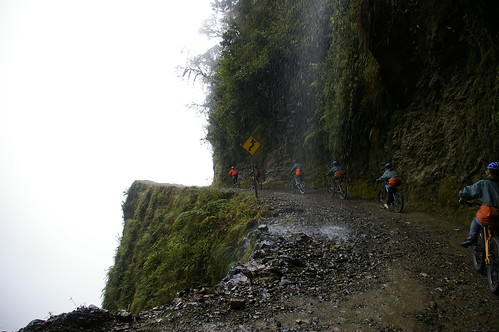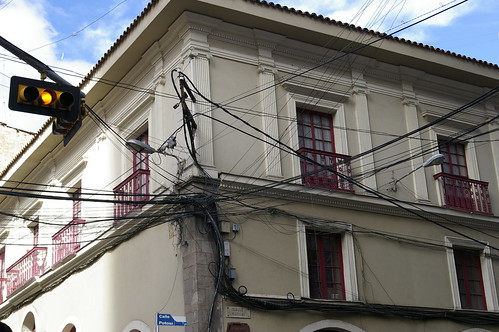Hola!
Apologies for the lack of activity, as in December I was preparing for an exam, and a day later, I flew to South America for a month – with these last few weeks my freetime has been eaten by creating some order at DataPortability. Despite the fact I knew one month wasn’t enough, and I visited too many countries that the travel was tiring and expensive, it still has been an amazing experience and I figure I might as well share my experience, as this blog did start as a travel blog.
From Tango in Buenos Airies to anaconda hunting in Bolivia, partying in Cuzco to experiencing the misunderstood Columbia – its been an amazing trip, where the people I’ve met on the way have made it just as rewarding as the places I visited. But if you have read my travel writing before, I am not going to bore you with “and then I did this and then I did that and oh my god, we then did that and it was so cool…”. Just some quick observations that may help you see what I saw.
“Self service toilets” – as oppossed to?….
The cities
First stop was Buenos Aires, where I spent close to week doing, um, not quite sure what I did. Buenos Aires is one of the stand out cities in the world, as I was told, but what I wasn’t told was why it’s a stand out city. And the answer is, is because it’s a cultural city. Meaning, there is sweet FA to do there as a tourist. But it’s a funky city to live in: densely urbanised with the town layout following the grid layout that is common across all the Spanish colonial cities, helping structure the urban jungle.
Coming into BA from the airport, I felt like I was driving into Athens: the heat, the run down buildings, and most of all the dirty roads which leave cars with a constant dirt on their sides and belly. Yet that was only the beginning of my comparisons with other cities, as BA’s 48 neighbourhoods each have a unique character and identity – from the slums of La Boca home of the famous Boca Juniors stadium, to the upmarket Riccoletta which had me thinking I was in Greenwich Village New York (the New York you see when watching sitcoms like Friends). Finally, two Melbournians pointed out to me that the city reminds them of Melbourne. One said the harbour is why, whilst my own observation was the grid-like structure of the city found in other great cities like New York, Thessaloniki and Melbourne was more the cause. (Yes, alright, I love the grid layout.)
I lost my photos for Argentina so you are going to have to settle with the urban sprawl of Bogota.
The consequence of a grid layout however is a cramped urban look, which I love about in cities, and which is what I believe is a common characteristic of cities with high culture. Whilst Argentina’s population density is 14 inhabitants per square kilometre, the city of Buenos Aires has a population density of over 14,000 inhab./km¬?. With so many people on the one area, no wonder this is a city that radiates culture. It is also no surprise why walking and getting lost in the neighbourhoods is one of the most enjoyable things to do.
Contrast that with La Paz in Bolivia, where I flew to next. Cities of the world tend to be compared to – for example, Buenos Aires, is called the “Paris of the South”, drawing comparison to one of the most beautiful cities I have ever seen. However with La Paz, I believe comparisons do not do it justice: it deserves to be a pin-up city that other cities can be compared to. And so therefore, whenever I say a city is the “La Paz of the …”, take that to mean, that that city is a shit hole that comes close to the biggest shit hole in the world.
Having said that though, I like shit holes. From the airport looking down, the city built on a mountains crest, certainly is spectacular – a geography it shares with Sarajevo, except about 4,000 metres above sea level and without any Serbs snipers. But whatever it is that makes it special, it certainly isn’t the ridiculous car pollution that I can’t help but claim is one of the landmarks of this third world country. I met a couple saying it’s been two weeks and they were still recovering from the altitude sickness which most people tend to get (including me): they didn’t realise those cars with engines from the 1930s probably are the cause. Getting out of the city was better than any pill you could take.
See that exhaust fume? Now times that by about 1000 and you get the idea what La Paz is like
The poverty is astounding, which is evident in the public works (or lack of). But one thing that strikes me, is that it just works. The overflowing markets in the city centre’s streets (I don’t use the word overflow lightly either) and the crazy amount of cars, give a chaotic feel – but like I said, it just works. It’s kind of cool (in the parts that don’t stink at least).
The other major cities I visited where Cusco in Peru, which is a pretty colonial city ruined by American package tourists, although to be fair, I was barely sober so didn’t get to see much as I was partying with some friends. I also went to Bogota in Columbia, a pleasant city, as well as Cali in the south which is one of the largest cities and centre of the cocaine industry. They also claim it is the salsa capital of Columbia (and the world) as well as having the most beautiful women. They do ok on both counts – going to a Salsa club, although expensive for a tourist, is certainly an experience; as for the latter, the reason why the guidebooks claim this as an attraction (other than because there is no much else to do in Cali but party and watch the homeless on crack cocaine) is because when you get a Latin Woman in a skimpy outfit due to the tropical weather (and that’s skimpy for all ages), no doubt men are going to rate this city highly. Sex will always beat high culture!
Coke, anyone?
The people
Argentineans and Columbians are some of the friendliest people I have ever come across. For example, standing on the Buenos Airies metro with my camera out like a stupid tourist – a lady approached me, urging me to hide my camera, due to theft which is so common in the city. (A big bloke from Sao Paolo who has never been robbed in his home city, an unusual occurrence, managed to get rolled here.) Other incidents and just the way people talk to you, is how I am basing my opinion of the friendliness of people. It’s the little things, but it shocked me particularly in Buenos Airies and Bogota as they are a big cities, which typically means everyone is a prick.
Bolivians I would have to say, whilst not exactly the least friendly, I was just shocked at how sloppy they were. The concept of hospitality is all but lost in Bolivia, it’s so ridiculous I couldn’t help but laugh. For example, at a restaurant on the way to Rubbenareque (where I did my Amazon trip), the way the waiter cleaned the food scraps on the table, was by wiping it to the floor, which was then cleaned by the resident dog.
Lake Tititaca – it’s big
Their attitude to the environment is a conservationists nightmare. I remember asking a lady where the bin was for my chips packet which I had finished, and she just pointed on the ground. I was confused, thinking what did she mean by that, and she just laughed and took the packet off me, throwing it to the ground. As you can imagine, our Amazon trip was very scenic later that week – monkeys, dolphins, and floating garbage.
An interesting thing about South America was the policing presence. For example in Bolivia, there seemed to be a military officer or at least a police officer at every store. Columbia’s roads are full of checkpoints, although then again, with a civil war in that country, don’t think I’m complaining. Unfortunately, I’ve lost my pictures of Argentina, but one of the funniest pictures I took was just off the city centre. You had the presidents palace – an ugly pink building, flanked by the Mayor’s building, the Cathedral, and on the same street as the courts and legislature. However directly behind the Presidents house, about 100 metres south-west, is the Ministry of Defence – a towering building many times bigger. Given the history of the region, the fact that there is a much grander defence building watching the presidents house, is not to be lost as a metaphor.
Another thing that shocked me was how much of a presence the indigenous people have. Whilst it would vary across the countries, with Argentina predominantly European and Columbia European and African; Peru and Bolivia were very much dominated by the dark skinned, sometimes Asiatic looking indigenous people, who draw from a variety of ethnic groups, and who all are descendants of sorts of the Incan empire that ruled the continent just before the Spanish. The colourful dresses of the Amyran women in the streets of La Paz is certainly a sight.
The politics
Unlike my previous nine-month trip in Europe, where I thought I was some traveling journalist reporting to the world, I got over I am not writing a guidebook, and realised this was a holiday to fix me up from getting burnt out after two years of fulltime study and work. However despite a monthy of literally switching off, I couldn’t help myself and went into reporter mode, questioning any South American I came across.
Doing our tour along the worlds most dangerous road
The over-arching theme that I took, was that this was a continent with amazing wealth, but overwhelming poverty and terrible government. Poverty is something that stares in your face – and I am told it is even more pronounced in Brazil. Whilst Brazil is the richest country because of its size, Argentina is regarded as the only developed country. Developed in that there is a stable government and economy, with a key difference being they have a vibrant middle class. Every other country, you notice there are the rich – who spend money in clubs like rich westerners – and there are the poor, which at times would distress me.
Our flight from Rubbeneraque to return to La Paz was delayed, which is an interesting example. The problem with Bolivia is that it has no infrastructure: something like 20-30% of the country’s roads are paved (I would love to be a tyre manufacturer there). The regional airports, like this one we were flying out from, was literally a grass field – with customs like some abandoned bus shelter. Actually, the plane couldn’t land due to the rain, and so they transported us to a neighbouring neglected military airport/grassfield about 40 minutes away, because the pilots managed to land it there. However as it rained, we had to wait for the water to drain as the plane couldn’t take off. This experience was an interesting insight into the poverty of Bolivia in particular, as it spurred a long discussion with a Austrian-born pilot now living in Bolivia.
Health and safety is clearly an issue in Bolivia
This man was one of the 70 pilots of the airline company Amaszonas, who was also one of the 23 owners and the National Operations manager of the company. There are four main airlines in Bolivia – three of them have struck an agreement to work together starting March 2008, with AeroSur doing internal flights, Amazonas doing domestic (going forward), and Aerocon doing the regional jobs like our flight today. The fourth airline, is TAM – a military transportation company, and one which our pilot friend claims is the governments attempt to kill local industry. He explain the Left-wing government has got a nationalistic, almost communist, drive. Rather than encouraging local industry, they are competing against it, trying to drive out these business so the government can have a state monopoly.
The streets of La Paz – worlds biggest shit-hole
He was moaning how it took 23 minutes to get into radio contact of the guy that was on duty at this neglected airport, which is a lot of burnt fuel and a good example of how there isn’t a supporting infrastructure for business to do things efficiently. On the point of getting the airport paved, which would mean these planes could land in any weather, at 120metres by 60 it would cost 12million USD – a price the industry could not subsidise, and one the government is not willing. And that’s why 37% of the December flights – and December is on the start of rainy season – had been cancelled. Our flight from La Paz got cancelled as we were checking in, which is why we opted for a jeep ride (and that was an experience). If it wasn’t for this landing at the neighbouring airport, and the last minute response from the on-duty airport controller, the flight would have had to have turned back to La Paz. The economic cost of this infrastructure problem, as you can see, is massive.
Talking to this pilot you have to be careful on his views, as he was in the top echelon of society – married to a Channel Nine newsreader with strong connections to politicians, and the owner of an airline – his bashings of the government is a very different perspective of the poor. But as he talked, it made me realise how much of a no hope the Bolivian’s have despite his optimism when President Morales was out. For example, despite rich in natural resources, the government has forbidden foreign corporations from extracting it. Arguably, these corporations abused the country and its population, hence this stance, but as our right wing friend claims, it’s because the government wants to do it itself to capture all the profits. The problem with that approach however, is you need foreign investment to build the infrastructure & transfer expertise that can’t be done by the Bolivians. And so you have this nasty poverty trap – where the government refuses to support foreign investment despite a clear need for it, and investors can’t invest because of the unstable political situation, which on the inside, isn’t really that unstable (according to him), but which to the outside, looks like another South American bananas republic about to collapse again.
With the poor, and this was especially evident in La Paz, you would see women and children sitting by the streets begging for money. However as I was told later by the pilot, you shouldn’t feel sorry for these people because they deliberately do this. He shared a story how he offered a woman a job as a cleaner in his house, but she turned it down, because apparently she would make more money begging. I don’t buy that as an explanation for all the beggers, but certainly an interesting insight.
The resident crocodile on our Amazon tour
And the rest
- Apparently, Venezuelan military planes fly in Bolivia! Hugo Chavez of Venezuela appears to be developing a confederate of allied nations, that look like another bloc of defiance against North America, taking on the leading role now that Cuba has its aged leader out of action.
- I lost my ATM card a few days into my trip! I found this out when I had about two dollars on me, and without another credit card, you can pretty much understand the situation I was in…along with my counterfeit money issue in Iran, I think the only travelers worst nightmare I haven’t experienced, is losing my passport! I managed to get an emergency visa sent to my employers Bolivia office, but turns out that didn’t work – so I was reliant on about $2000 in wire transfers from family via the god send Western Union (thank God South America is cheap). Western Union is literally available anywhere – there are branches within post offices in Argentina, chemists in Peru, as well as banks and their own banks. At a $70 transfer fee, this is one of the travellers best resources when they are in trouble. On the flip side, I HATE YOU ST GEORGE BANK. It took me 20 minutes to try and call an after hours emergency number, and I ended up having to get my folks at home to call directory assistance, because their website is full of marketing crap. Don’t get me started on the rest.
- I did a three day Amazon tour on the pampas, and I feel like I need to share my research with the other poor travellers trying to prepare.
- Bolivia has apparently the cheapest Amazon tours with the most to see. All the tour agencies pretty much have cabins off the same river, and cost the same. Indigena has the cheapest; Inca tours the most expensive with mine middle of the range (Fluvial tours) – and for the same product
- Flights to Rubbenareque can get cancelled at the last minute, which is the best way to travel and takes an hour (about 70USD); a 4×4 “jeep” takes 12 hours (about 55USD if you can get five people to share the ride); and the bus 20 hours (something like 10USD). Although the bus is cheaper – I’ve seen and heard from others why you shouldn’t; the jeep is a good experience to see the countryside but the bumpy roads can get very tiring, and make sure you leave early in the morning, because our driver post 12am starting getting very tired and was just trying to get there ASAP – which made the ride even more uncomfortable (at around 3 am, I felt he was purposely trying to hit the holes in the road, to keep himself awake!). The entire road to Rubbenareque can best be described as a wide goat track alongside a mountain cliff that drops 100 metres at times. The fact you have industrial trucks and buses traveling on a road that a car barely fits on, adds to the problem – if you are on the bus, to make way for other cars, there is a constant reversing and adjusting ON CLIFFS!! So that’s the reason the bus takes so much longer, and passengers fear for their lives. Actually, just ahead of us we witnessed a truck that fell off the road and crashed to the bottom – accidents are common.
- As for contacting tour agencies, they all have websites that suck – it’s best to just turn up to La Paz or Rubbenareque and book there – they have tours running every day (we had one over Christmas).
- The details for Indigena tours in La Paz, which you won’t find anywhere on the net, is the following:
SAGARNAGA STREET (which is on the main tourist street filled with tours, at the very top of the road) NEAR TO ILLAMPU STREET N?Ǭ? 380 PHONE NUMBER 2110749. E-mail is indigenabolivia at hotmail dot com
- They are the best because they are the cheapest, and the lady in La Paz is very helpful
And that’s all! Plenty more to say, but message me if I can help anyone trying to plan a trip; as for the wisdom I have acquired, lets do that over a beer 🙂












